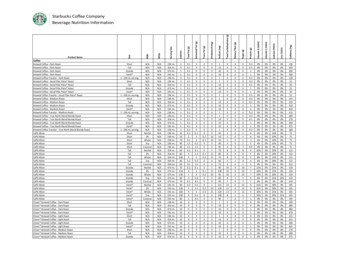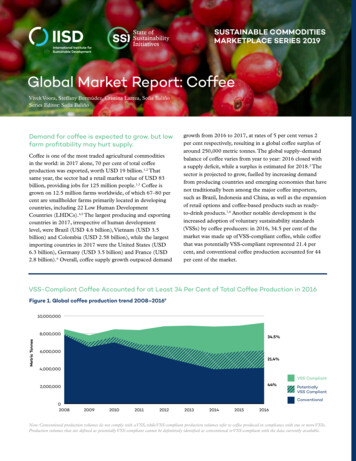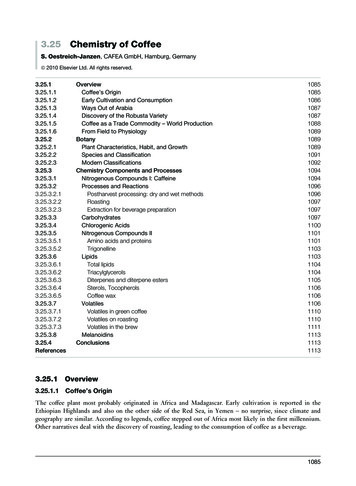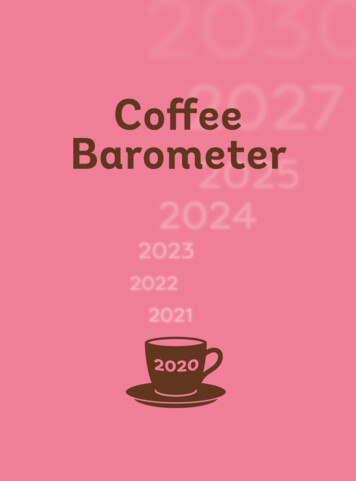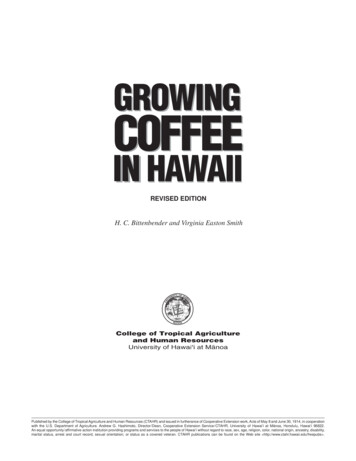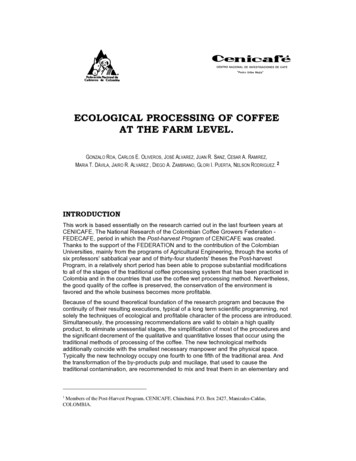
Transcription
THIS REPORT CONTAINS ASSESSMENTS OF COMMODITY AND TRADE ISSUES MADE BYUSDA STAFF AND NOT NECESSARILY STATEMENTS OF OFFICIAL U.S. GOVERNMENTPOLICYRequired Report - public distributionDate: 5/15/2019GAIN Report Number: ID1911IndonesiaCoffee AnnualIndonesia Coffee Annual Report 2019Approved By:Garrett McDonaldPrepared By:Arif Rahmanulloh and Garrett McDonaldReport Highlights:Domestic consumption continues to increase due to strong demand for Ready-to-Drink coffee productsand expansion of coffee retail outlets. Exports are down due increased competition from Vietnam inkey markets, including Russia, E.U. and China. Production for 2019/20 is forecast to increase slightlyfor both Arabica and Robusta varieties.
Commodities:Coffee, greenCrop AreaCrop area in 2019/20 is forecast to remain steady at 1.2 million hectares. Smallholder plantationsaveraging between 1 to 2 hectares continue to account for 98 percent of all area, though several largescale plantations reaching up to 4,000 hectares are in Sumatera and Java.Sumatera remains Indonesia’s largest coffee producing region, producing between 70 – 75 percent of allgreen bean coffee. Robusta production accounts for approximately 80 percent of total production and iscentered in Southern Sumatera’s Lampung and Bengkulu regions. Higher valued Arabic varieties areprimarily grown in Northern Sumatera, though Arabica production has increased in West Java and Bali.ProductionIn 2019/20, coffee production is forecast to reach 10.7 million bags, an increase of 100,000 bags from2018/19. Farmers in the major Robusta production area of Southern Sumatera have reported no extremeweather issues during flowering and bean development stage. As a result, improved yields are expectedduring the first harvest, which will peak in May-June.Heavy rainfall has delayed Arabica harvesting in West Java. Despite Java’s small Arabica productioncompared with Northern Sumatera, the region has seen steady increases in production as more farmersreplace vegetables with coffee and area expands in government forestry lands. Much of the West JavaArabica production is sold domestically to meet increased consumer demand for coffee, though somevolumes are exported directly or shipped to Medan in North Sumatera for blending with other Arabicabeans.Production for 2018/19 is lowered 300,000 bags to 9.4 million bags based on lower than expected outputof Robusta beans. Higher yields in Southern Sumatera regions, such as Pagaralam, were not enough tooffset lower Robusta yields in highland areas resulting from heavy rain and high winds during cherrydevelopment.Table 1. Indonesia coffee production (million 60-kg 2019/201.259.4510.7InputsMost smallholder farmers utilize few inputs for their coffee crops. Fertilizer and pesticides are limitedin use and are usually applied with the assistance from local collectors who have a stake in ensuring acrop’s production. Daily maintenance activities, such as weeding or pruning, are often carried out byfarmers themselves with assistance from family labor. The harvest periods require additional labor,
which is often arranged between farmers of the same area who rotate from farm to farm to assist oneanother. Planting materials, such seedling, are available locally in small quantities, often provided bymore experienced farmers. Improved-yield seedlings are distributed by local governments, but in smallquantities and irregularly. Most area is un-irrigated.Figure 1. Farmer’s Nursery of Arabica in West JavaYieldsCoffee yields are generally low for both Robusta and Arabica varieties, both in terms of potential andcompared with other major producing countries. Robusta yields vary by regions, but generally rangebetween 700-1000 kilograms per hectare. The lower yields are often the result of limited fertilizer orcrop protection inputs, the quality of planting material, and the absence of extension services in manyareas. Weather also plays an important factor, as heavy rainfall and strong winds may threaten variousstages of development.ConsumptionConsumption for 2018/19 is increased to 4.3 million bags, based on strong consumer demand for freshroasted, soluble and Ready to Drink (RTD) products. Consumption for 2019/20 is forecast at 4.9million bags based on continued strong consumer demand. Indonesia’s booming coffee-drinkinglifestyle continues to expand in urban areas. Coffee outlets, both chain and independent, are opening innearly every shopping center, transportation hub and office complex.Table 2. Chain Coffee Shops in Indonesia Continue to expandChain coffee shopsFirst OpeningNumber of outlets and city coverageStarbucks2002403 in 25 Cities (2019)Maxx Coffee201483 outlets in 23 Cities (April 2019)Coffee Toffee2006126 outlets in 30 cities (2016)
The Gade Coffee & Gold201833 Outlets in 30 cities (2019)Industrial processing capacity for coffee products has increased from approximately 250,000 tons in2015/16 to 300,000 tons in 2018/19. The increase can be attributed to newcomer mid-size processorsand expansion among existing processors. New coffee products frequently enter the market, expandingthe variety of flavors and packaging sizes.In particular, demand for RTD coffee products has increased significantly. RTD coffee has experiencedrecord sales growth through convenience stores, supermarkets, and traditional grocery outlets.Figure 2. Indonesia RTD Coffee Retail Sales Volume 2013-2018 (million liters)Source: Euromonitor Passport (March, 2019)TradeExportsGreen bean exports in 2018/19 were the lowest since 2001, falling 29 percent from 6.94 million bags in2017/18 to 4.907 million bags. Shipments to Russia, E.U. and China all dropped significantly, as buyersswitched their Robusta sources, mainly to Vietnam. Over the same period, Robusta prices decreased 16percent.Major export markets include U.S., Malaysia, Japan, Egypt and Italy. Volumes peaked in Julyfollowing the main harvest period of March-June in Southern Sumatera.In 2019/20, green bean exports are forecast to rebound to 5.7 million bags assuming more competitivepricing with upcoming harvest period in Southern Sumatera. Demand is expected to increase fromtraditional export markets as shipments during January-March 2019 reached 71,000 tons, a 31 percentincrease over the corresponding period in 2018.
Figure 3. Indonesia green bean exports January-March 2017-2019Source: GTAFigure 4. Indonesia Green Bean Exports and World Robusta Price 1996-2018Source: GTA, indexmundi
Figure 5. Indonesia Green Beans Export Markets 2017 vs 2018 (ton)Source: GTAImportsThe high level of stock carryover from the 2018 harvest reduced green bean imports by 84 percentduring the peak import period of January - March 2019. Normally, during this period there is a spike inimports from Vietnam following their main harvest as domestic stocks reach low levels beforeIndonesia’s main harvest period of March – June. The high carryover stocks leading into the firstharvest of 2019 are expected to lower green bean imports by 274,000 bags to 400,000 bags in 2019/20.PriceThe following table shows spot prices published by the Indonesia Commodity Futures RegulatoryAgency (Bappebti) for both Robusta and Arabica varieties. These local spot prices are derived using aformula for international futures and forward price as a reference.
Table 3. Robusta Spot Price at Lampung 2014-2019 28Source: BappebtiTable 4. Arabica Spot Price at Medan 2014-2019 0064,09359,86557,881Source: 57,45152,077201952,10149,68348,34246,849
Table 5. Average Monthly Exchange Rate of IDR to U.S. ,268Source: Bank of IndonesiaCo ffe e , Gre e nMa rk e t B e g in Y e a r2017/ 20182018/ 20192019/ 2020A p r-17A p r-18A p r-19USDANewUSDANewUSDANewInd o ne s iaOffic ia lP o s t Offic ia lPo stOffic ia l P o s tArea Planted1,2501,2501,2501,2501,250Area Harvested1,2101,2101,2101,2101,210Bearing Trees1,1601,1601,1601,1601,160Non-Bearing Trees1515151515Total Tree Population1,1751,1751,1751,1751,175Beginning Stocks12125935932,419Arabica Production1,0001,0001,2001,2001,250Robusta Production9,4009,4009,7009,4009,450Other ProductionTotal Production10,40010,40010,90010,60010,700Bean Imports875875600674300Roast & Ground Imports4848151915Soluble Imports828828850983900Total Imports1,7511,7511,4651,6761,215Total Supply12,16312,16312,95812,86914,334Bean Exports6,9406,9407,0004,9075,700Rst-Grnd Exp.7070404345Soluble Exports1,0001,0001,1001,2001,300Total Exports8,0108,0108,1406,1507,045Rst,Ground Dom. Consum2,6502,6502,9003,1003,400Soluble Dom. Cons.9109101,0001,2001,500Domestic Consumption3,5603,5603,9004,3004,900Ending Stocks5935939182,4192,389Total Distribution12,16312,16312,95812,86914,334(1000 HA) ,(MILLION TREES) ,(1000 60 KG BAGS)
May 15, 2019 · Coffee Toffee 2006 126 outlets in 30 cities (2016) The Gade Coffee & Gold 2018 33 Outlets in 30 cities (2019) Industrial processing capacity for coffee products has increased from approximately 250,000 tons in 2015/16 to 300,000 tons in 2018/19. The i

